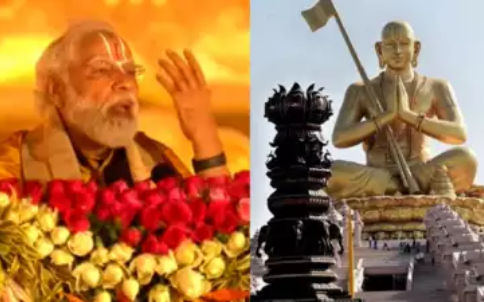Part II
Prime Minister Narendra Modi referred to Bhakti Movement leader Narsi Mehta, on 5th February, 2022, while unveiling the statue of equality- of Jagadguru Ramanuja. The PM says Ramanuja influenced Narsi Mehta in Gujarat, Kanakadas in Karnataka, Annamayya among Telugu people, Goswami Tulasidas and Kabirdas in northern states.
Narsi Mehta penned a Bhajan, which Mahatma Gandhi loved most. Bhajan begins with “Vishnava Janatho tenekahiye peed paraayee jaaneere…” which means “one who knows pain of the others alone is Vaishnav”. Ramanuja believed in it, preached about and practised all through.
One thousand years ago, Bhagavad Ramanuja was born to establish Narayana Tatwa. He lived till today and will live forever. All times and always he will be remembered, referred and revered. Sri Vaishnavam is his Dharma, also called Ramanuja Dharma. Father of our Nation Mahatma Gandhi used to love one bhajan which according to Ramanuja, expression ‘Vaishnava’ does not mean one who is born in the caste of Vaishnava, a sect of Brahmins, but one who is real devotee of Vishnu, irrespective of his caste at birth.
Karma (action) decides, not Janma (birth)
He led the re-establishment of Vishishtadvaita philosophy in southern India during later part of Tenth century. Important temples like Tirupathi, Srirangam and Kancheepuram were headed by Vaishnava philosophers. These philosophers believe in karma and not janma, thus the Head of the Vaishnava pontiffs at Srirangam temple, Yamunacharya, a sage and scholar par excellence groomed a disciple Kanchipurna born in Sudra (lower) caste but with his great deeds and scholarship achieved pious status and gained reverence of many. The modern society should know that there is a temple for Kanchipurna in Kanchipuram, where he is worshipped every day. Ramanuja distributed knowledge to all and roped in every person qualified ignoring the caste at birth establishing the norm that Guna (character) and Karma (actions) will decide his caste of person and not the Janma (birth). He dreamt and practised inclusive policies with merit of karma alone as basis.
Scholarly Negotiations
He waged intellectual wars with enemies to Hindu Dharma with strength of his knowledge and convincing power at negotiations. His best was in Tirupathi, when Shaivas –devotees of Lord Shiva argued that the Moola Viraat was Eswara, while the Shakteyas contended Shakti Maa and Kartikeyans vehemently put forward their plea that Kumara Swamy manifested Himself in Tirumala. Ramanuja negated every contention of the three and produced convincing evidence to establish that He is Lord Vishnu as Srinivasa.
With his in-depth study, scholarly interpretations and skillful preaching, Sri Ramanuja took the non-dualism to its greater heights defeating every competing contender. He was the exponent of the Visishtadvaita concept i.e., qualified non-dualism. Ramanuja’s Brahman is Sa-visesha Brahman, i.e., Brahman with good (karma related) attributes. According to Acharya Ramanuja’s teachings, Narayana is the Supreme Being; the individual soul is Chit (the living light); matter is Achit (lifeless material). Ramanuja regards all the attributes as real and permanent, but subject to the control of Brahman. The attributes are called Prakaras or modes. Lord Narayana is the Ruler and Lord of the SakalaVishvam i.e., the entire Universe. The Jiva is His servant and worshipper. The Jiva should believe in SampoornaSaranagathi, completely surrender himself to the Lord. The oneness of God is quite consistent with the existence of the attributes, as the attributes or Shaktis depend upon God for their existence.
Yamunnacharya’s wish
PeriaNambi was sent by his Guru His Holiness Acharya Swamy Yamunacharya to bring Ramanuja to Srirangam. Ramanuja considered it as a great fortune to have been invited by such a pious personality. But by the time he could reach Yamunacharyar has left his physical body for the Paramapada. Ramanuja was much agonized and craved for knowledge. However, from his three folded fingers, he could understand that three desires of Yamuncharya need to be fulfilled. He enquired with his disciples to guess what he wished. To great surprise of all present there, each finger of his body was unfolded as he promised one by one to fulfill the desires. Yamunacharya wanted Ramanuja to take forward the mantle of Vishishtadvaitha philosophy as the next Acharya. Ramanuja felt divine voice from Yamunacharya’s soul: “My child, I wish you personally meet the great Acharya ThirugoshtiyurNambi (Goshtipurna) for knowing the eternal meaning of the Dwayamantram along with the significance of the Eight syllable Astakshari-Thirumantra..Om NamoNaaraayanaaya.”
Divine order
Ramanuja was overwhelmed with Yamuna Acharya’s divine order and decided to travel. Thirukoshtiyur is 150 miles from Srirangam. Thirukoshtiyur is worshipped as the Srivaishnavadivyadesam of Lord Sowmya Narayana Perumal. Goshtipurna worshipped with love and devotion this Lord and lived here all through his life. On foot, Ramanuja reached Thirukoshtiyur, and enquired about house of Goshtipurna. The villagers were surprised to hear this name. Acharya was so simple and devoted that many of the villagers do not know his greatness. Someone recollected his residence and shown the poor hut.
Prime Minister referred to some of these historic events in the life of Ramanuja and said he is one who strived for integrating India.
Also read: Ramanuja who broke the law of secrecy
Prof. Madabhushi Sridhar,
Former Central Information Commissioner &
Dean, School of Law Mahindra University, Hyderabad




